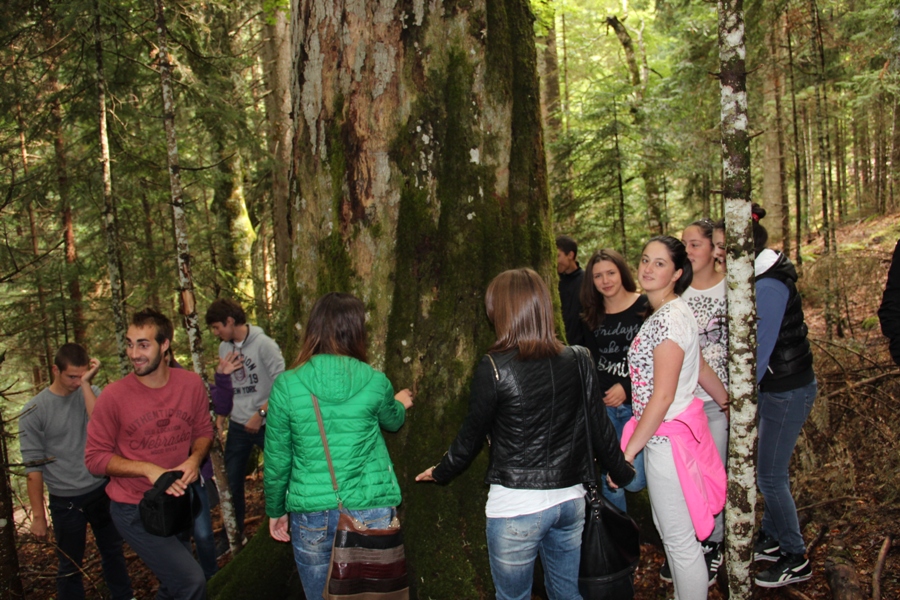Within the activities of the “Tour natural heritage sites and collecting materials” in Zabljak during the period from 10.09 to 13.09.was held the second of the six planned visits to natural heritage sites.On this occasion, the participants visited destinations: Curevac, Tepca and Crna Poda and learned more about the endemic and endemic relict species in the area of Durmitor and the Tara canyon.
Durmitor is a regional unity, consisting of five canyons, and its the diversity of flora and fauna is owed to the touch of two great geographical regions: the Mediterranean and Euro Siberian. It is estimated that in this area there are more than 1,500 plant species. Some of them have their origin in the distant geological past, and on the slopes of this massif can be found species that are specific for the distant Arctic. In the canyons of Piva and Tara, are preserved some kind of tertiary flora from the Ice Age, and peatlands in the Durmitor lakes are enclaves, specific for the Siberian taigas.
Endemic species are 15% of the whole alpine flora (122 species), while in relation to the entire endemic flora of the Durmitor’s massif, even 77% are high-mountain endemics.
In the higher regions, the most widespread is softwood: spruce, fir and pine, and deciduous trees: birch, beech, aspen and maple. In the lower regions, there are oak, elm, linden, maple, dogwood and more. Rare species are whitebark pine, yew, calico, dwarf pine and juniper.
There is very interesting and rare occurrence of so-called “forest inversion”, because in many places above the level of the softwood, appears covering of the deciduous vegetation beech. The abundance and diversity of plants on the meadows and the cliffs of Durmitor is still undetermined, but many species are protected because of exceptional scientific importance. Many endemic species grow there: MULLEIN, NIKOLINA’S VIOLET, MONTENEGRIN BELLFLOWER, MALIJEV JEREMICAK, RAUN BRAKEOV VALERIAN, TARSKI BLUEBELLS, A LADY’S-SLIPPER ORCHID, SIPARSKA HAJDUČICA, MLAĐA, SNEAKING BELL, DINARSKA SIRIŠTARA … Over 40 species of wild edible mushrooms grow on the mount Durmitor and it is considered a special reserve in Europe.
This area is populated with diverse fauna, about 300 animal species are protected. By abundance and significance, the first place belongs to invertebrate, with a large number of rare and endemic species, especially among insects. In summer, the flowery meadows, as nowhere else, one can see a multitude of different species of butterflies and beetles (about 130 species of butterflies), and among them thebutterfly Apollo, which is due to its beauty, the most frequent targets of collectors and was placed under protection.The mammal world consists of bear, chamois, roe deer, wolf, hare, wild boar, marten, fox, dormouse and others, while the otter, which lives in the Tara River, is among rarities in Europe. On Durmitor area there are 168 species of birds, including rarities as like BLACK GROUSE, GOLDEN EAGLE, PARTRIDGE, HAWK, GRIFFON VULTURE …..
The viewpoint Curevac (1625 m). From this point you can see the mountain Durmitor and the Tara canyon where the river meandering flows in the stone cliffs. The vertical of over a kilometer leading to the village, called Tepca, with countless formerly cultivated terraces stretches arc along the left bank of Tara. It flows there “The Tear of Europe” at about 550 meters above sea level. Like a cut furrow between mountain peaks flows clear mountain river, and its water from time to time makes wonderful landscapes in tame and fertile valleys where there are acres, orchards, forests and meadows with grazing herds of sheep and goats and very often together with wild animals, which is full of valleys and river canyon. The river flows even further through the abyss over which, on its stony slopes the lonely pines grow, it would seem, from the stone cliff, which plunge into the depths of the abyss of this famous canyon.
Due to the quality of its water and the unique eco-system, Tara was included in the program “Man and Biosphere” and an ecological biosphere reservation in 1977, which is protected by internationally adopted convention.
The flora of the river Tara has managed to preserve many plant species originating from the distant past. The most interesting thing is that many of these species have managed to preserve their primeval characteristics typical for the distant past. Thus, in the valleys of the Tara we can see the certain preserved types of tertiary flora from the Ice Age. Besides these species, the flora in the canyon is characterized by forests of different species: oak, ash, beech, black ash and birch. A large part of the canyon is overgrown with softwood, and among them a special place takes the black pine.
The most interesting secies of the black pine are those which hang on bare stony slopes, and thus hang over the abyss. But the most famous site where the black pine makes the rainforest, is located in the canyon at a place called ‘Crna Poda’.The place ‘Crna Poda’has been declared as a strict nature reservation. The place‘Crna Poda’is 1.5 km long and 500m wide, in this the black pine reservation there is the tallest trees in Europe (50 m), aged 400 years. Also the most beautiful orchids in Europe, a lady’s-slipper orchid grows there, which is a protected species and it is estimated that in the area of Crna Poda’ has only about 50 specimens of this species.
30 students (15 from Foca and 15 from Zabljak), together with their professors took part in this tour.
A lot of photos and video clips were taken and recorded , which were later being processing together by students in the school premises.
A large number of students, from both sides of the border, expressed their wish to continue the hanging out with their new friends and participate in future projects.
Within this tour the participants visited the Natural Museum in the National Park ‘Durmitor’.



 BiH
BiH MNE
MNE